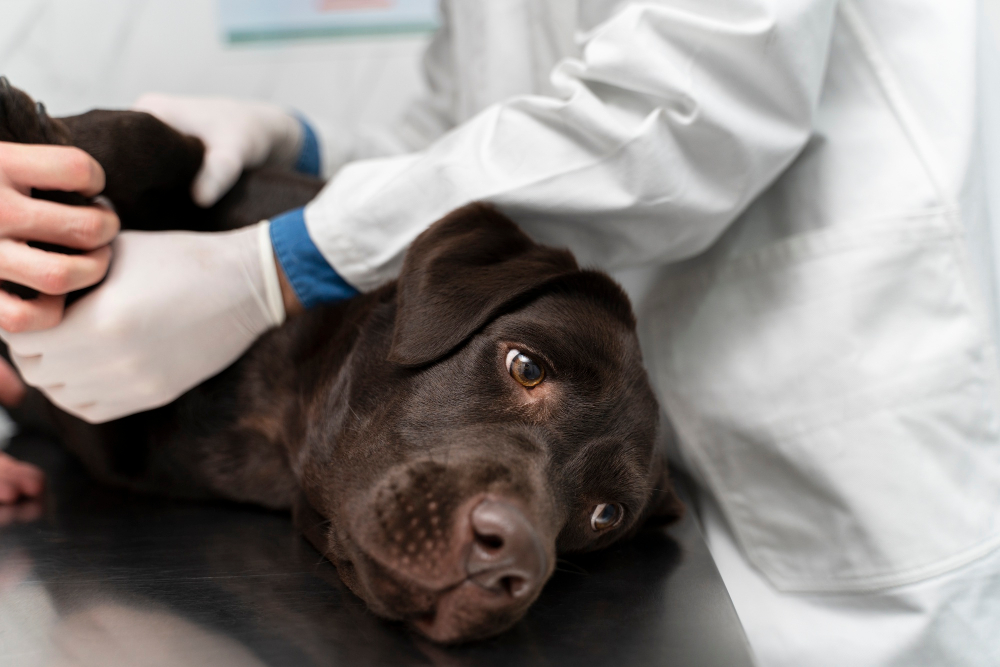Ehrlichiosis is a tick-borne disease that affects dogs worldwide. If you’ve ever wondered how to protect your furry friend from this illness or what to do if your dog has been diagnosed, you’re in the right place. In this article, we’ll cover everything you need to know about ehrlichiosis, from its causes to prevention tips, in a friendly and easy-to-understand way. Let’s get started!
What Is Ehrlichiosis in Dogs?
Ehrlichiosis is an infectious disease caused by bacteria from the genus Ehrlichia. These bacteria are transmitted to dogs through tick bites, particularly from the brown dog tick (Rhipicephalus sanguineus). Once in the bloodstream, the bacteria infect and damage white blood cells, leading to a range of symptoms that can vary in severity.
This disease can affect dogs of any age, breed, or size, making it essential for all pet owners to be aware of the risks.

Types of Ehrlichiosis
There are three stages of ehrlichiosis in dogs:
Acute Phase
- Occurs 1 to 3 weeks after infection.
- Symptoms may include fever, lethargy, loss of appetite, swollen lymph nodes, and occasional bleeding (like nosebleeds or bruising).
- If treated early, dogs can recover quickly during this stage.
Subclinical Phase
- This is a “silent” phase where the dog shows no visible symptoms but remains infected.
- The bacteria can persist in the body for months or even years.
- Without treatment, it can progress to the chronic phase.
Chronic Phase
- In this stage, the disease becomes more severe and harder to treat.
- Symptoms may include anemia, weight loss, swollen limbs, neurological issues, and increased susceptibility to infections.
How Do Dogs Get Ehrlichiosis?
Ticks are the primary culprits behind ehrlichiosis. Here’s how it happens:
- A brown dog tick bites an infected animal (like another dog or wildlife) and picks up the Ehrlichia bacteria.
- The tick then bites your dog, transmitting the bacteria into their bloodstream.
Since ticks thrive in warm climates and grassy or wooded areas, dogs that spend a lot of time outdoors are at a higher risk.
Symptoms of Ehrlichiosis in Dogs
The symptoms of ehrlichiosis depend on the stage of the disease but may include:
- Fever
- Lethargy
- Loss of appetite
- Swollen lymph nodes
- Bruising or bleeding (e.g., nosebleeds or blood in urine)
- Joint pain and lameness
- Neurological symptoms (e.g., seizures or unsteady gait)
- Weight loss
- Pale gums (indicating anemia)
If you notice any of these symptoms, it’s essential to contact your vet right away.
Diagnosing Ehrlichiosis
To diagnose ehrlichiosis, your vet will likely perform:
- Blood Tests: These can detect abnormalities like low platelet count, anemia, or elevated liver enzymes.
- Antibody Tests: To check for the presence of antibodies against Ehrlichia bacteria.
- PCR Test: A more precise test to identify the DNA of the bacteria in your dog’s blood.
Early diagnosis is key to effective treatment, so don’t delay if you suspect your dog might be infected.
Treatment for Ehrlichiosis in Dogs
The good news is that ehrlichiosis is treatable, especially when caught early. Here’s what the treatment typically involves:
Antibiotics
- Doxycycline is the most commonly prescribed antibiotic for ehrlichiosis. Treatment usually lasts 3 to 4 weeks.
Supportive Care
- In severe cases, dogs may need hospitalization for IV fluids, blood transfusions, or pain management.
Follow-Up
- Your vet may recommend follow-up blood tests to ensure the infection has been cleared.
Most dogs respond well to treatment, especially during the acute phase. However, the chronic phase can be more challenging to manage.

Preventing Ehrlichiosis in Dogs
Prevention is always better than cure. Here’s how you can reduce the risk of ehrlichiosis:
Tick Prevention
- Use vet-recommended tick preventatives like collars, topical treatments, or oral medications.
Regular Checks
- Inspect your dog’s fur and skin for ticks after outdoor activities, especially around the ears, neck, and underbelly.
Keep the Environment Tick-Free
- Maintain your yard by mowing the lawn regularly and removing leaf litter.
- Use tick repellents in areas where ticks are common.
Avoid Tick-Prone Areas
- Be cautious in wooded or grassy areas during peak tick seasons (spring and summer).
Routine Vet Visits
- Regular check-ups can help catch infections early or ensure your dog’s tick prevention methods are effective.
Can Ehrlichiosis Spread to Humans?
Yes, but not directly from dogs. Humans can get ehrlichiosis from tick bites, but the disease cannot be transmitted through contact with an infected dog. Protecting your dog from ticks also reduces the risk of ticks in your home and yard, keeping your family safer too.
Final Thoughts
Ehrlichiosis in dogs is a serious but manageable disease. By staying informed, practicing good tick prevention, and seeking prompt veterinary care, you can protect your furry friend from this tick-borne illness.
Have questions or personal experiences with ehrlichiosis in dogs? Share them in the comments below—we’d love to hear from you!








